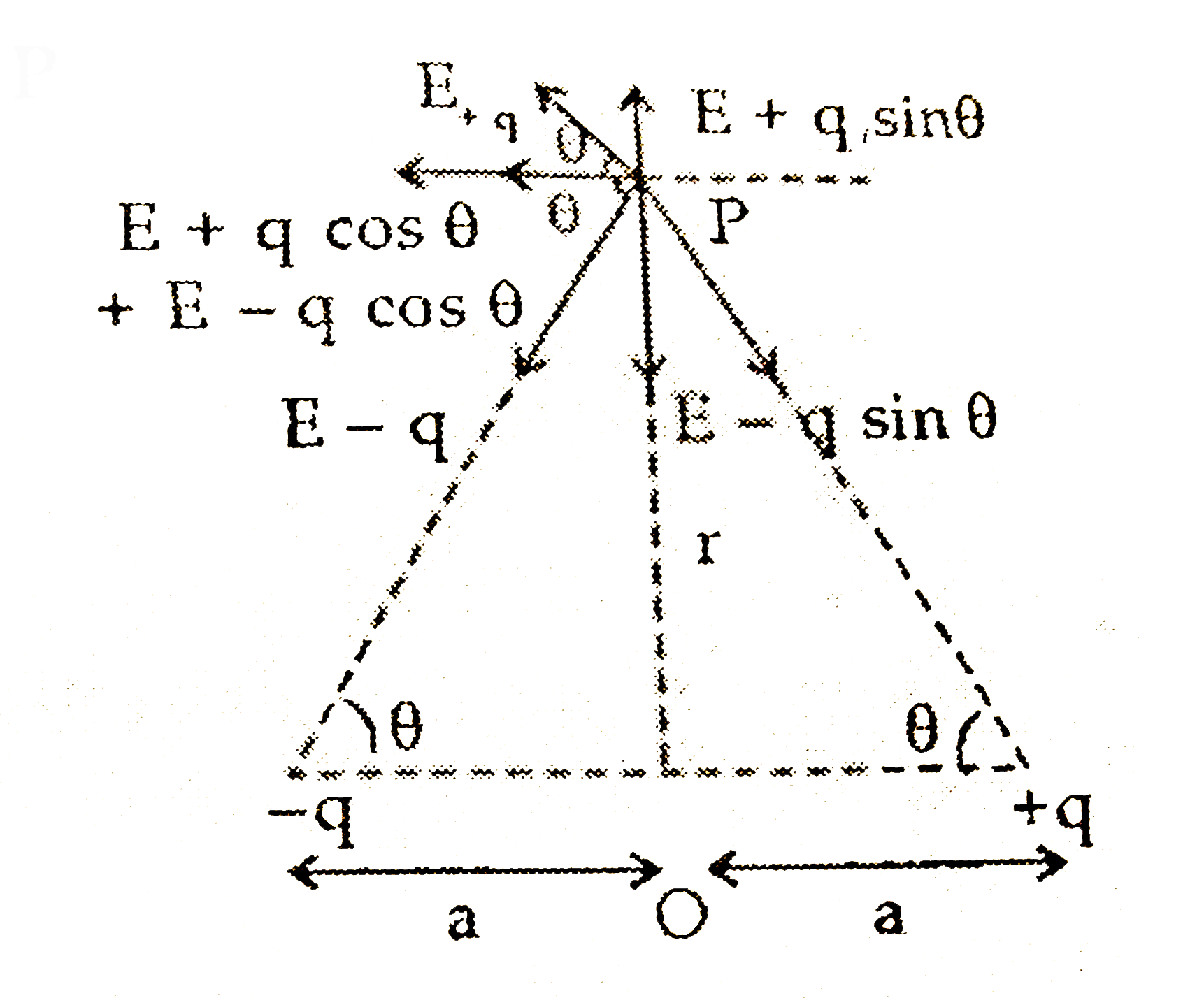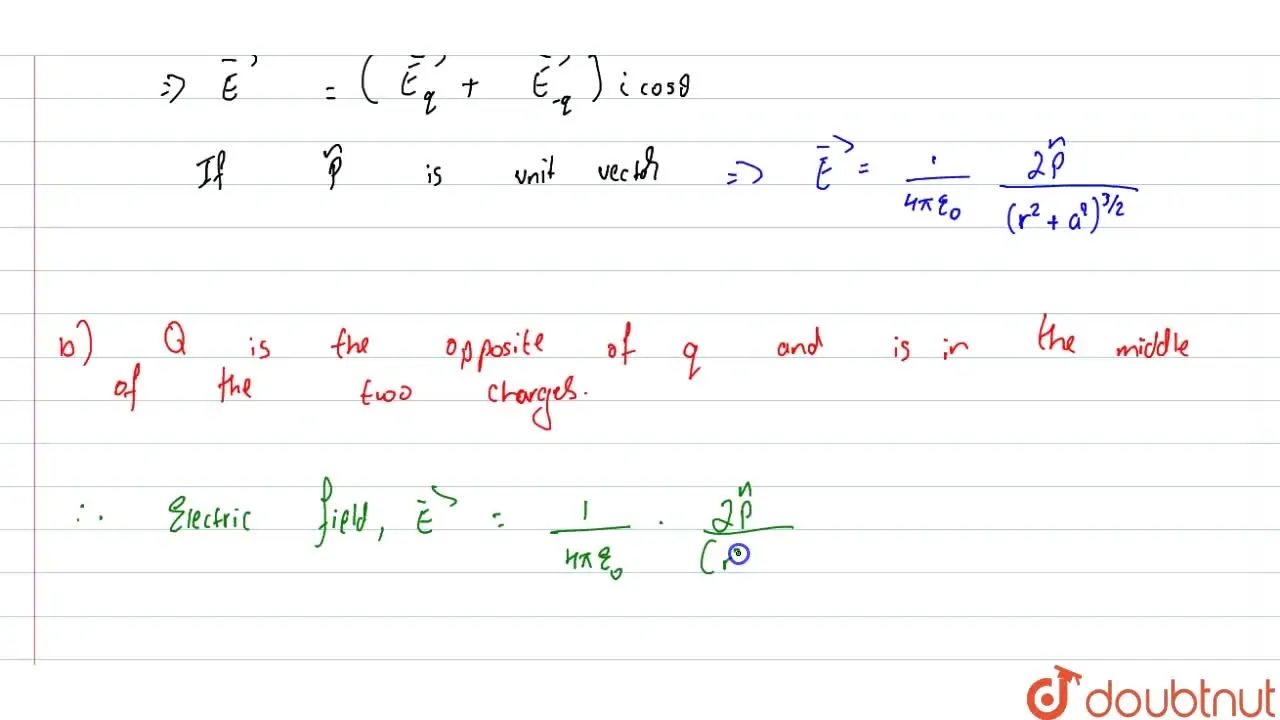Answer the following:
(a) Derive and expression for the electric field at any point on the equatorial line of an electric dipole.
(b) Two identical point charges, q each kept 2m apart in air. A third point charge Q of unknown magnitude and sign is placed on the line joining the charges such that the system remains in equilibrium. Find the position and nature of Q.
(a) Electric field intensity at point P due to + ve q charge at point P

∣∣→E+q∣∣=14π∈0q(r2+a2) ...(1)
Electric field intensity at point P due to - ve q charge at point P
∣∣→E−q∣∣=14π∈0q(r2+a2) ...(2)
Hence, ∣∣→E+q∣∣=∣∣→E−q∣∣
E+qsinθandE−qsinθ are equal in magnitude and oppsite in direction so they cancel out.
Net electric field at point P
E=2E+qcosθ
E=214π∈0q(r2+a2)a(r2+a2)1/2
E=14π∈02(2a)(r2+a2)3/2
P=q(20)
Where P is electric dipole monent
E=14π∈01(r2+a2)3/2
Vetor form →E=14π∈01(r2+a2)3/2
(b) As charge θ is in equilibrium net force on the charge θ is zero
14π∈0−14π∈0qQ(2m−x)2=0

14π∈0qQx2=14πqQ(2m−x)2
x=2m−x
2x=2m
2=m
Hence, Q is at the mid point of the line joining the charge q and q.
as the whole system is also in equilibrium, force an the charge q must also be zero.
14π∈0qQx2+14π∈0qq(2m)2=0
14π∈0qQx2+14π∈0qq(2m)2=0
Qx2=−q4m2 as x=m
Q=−q4
Related Playlists
- BOOK - XII BOARD PREVIOUS YEAR PAPER ENGLISHCHAPTER - XII BOARDSEXERCISE - SET-I (SECTION-A)4videos
XII BOARDS
- BOOK - XII BOARD PREVIOUS YEAR PAPER ENGLISHCHAPTER - XII BOARDSEXERCISE - SET-I (SECTION-B)5videos
XII BOARDS
- BOOK - XII BOARD PREVIOUS YEAR PAPER ENGLISHCHAPTER - XII BOARDSEXERCISE - Section-E17videos
XII BOARDS
- BOOK - XII BOARD PREVIOUS YEAR PAPER ENGLISHCHAPTER - SAMPLE PAPER 2019EXERCISE - SECTION D6videos
SAMPLE PAPER 2019
Similar Questions
Derive an expression for intensity of electric field are a point in broadside position or on an equatorial line of an electric dipole.
View Solution(i) Derive the expression for electric field at a point on the equatorial line of an electric dipole.
(ii) Depiet the orientation of the dipole in (i) stable, (ii) unstable equilibrium in a uniform electric field.View SolutionAnswer the following:
(a) Derive the expression for the electric potential at any point P, at distance r from the centre of an electric dipole, making angle α, with its axis.
(b) Two point charges 4μCand+1μC are separated by a distance of 2m in air. Find the point on the line joining charges at which the net electric field of the system is zero.View SolutionTwo point charges +q and +4q are a distance l apart. A third charge q1 is so placed that the entire system is in equilibrium. Find the location, magnitude and sign of the third charge.
View SolutionTwo points charges +4q and +q are separated by distance r, where should a third point charge Q be placed that the whole system remains in equilibrium
View SolutionIf Two charges +qand+4q are separated by a distance d and a point charge Q is placed on the line joining the above two charges and in between them such that all charges are in equilibrium. Then the charge Q and it's position are
View SolutionTwo point charges +q and −q are placed a distance x apart. A third charge is so placed that at the three charges are in equilibrium. Then
View SolutionA charge q is placed at the centre of the line joining two equal charges Q. The system of the three charges will be in equilibrium if q is equal to:
View SolutionA charge q is placed at the centre of the line joining two equal charges Q. The system of the three charges will be in equilibrium if q is equal to:
View SolutionA charge q is placed at the centre of the line joining two equal charges Q. The system of the three charges will be in equilibrium if q is equal to:
View Solution


